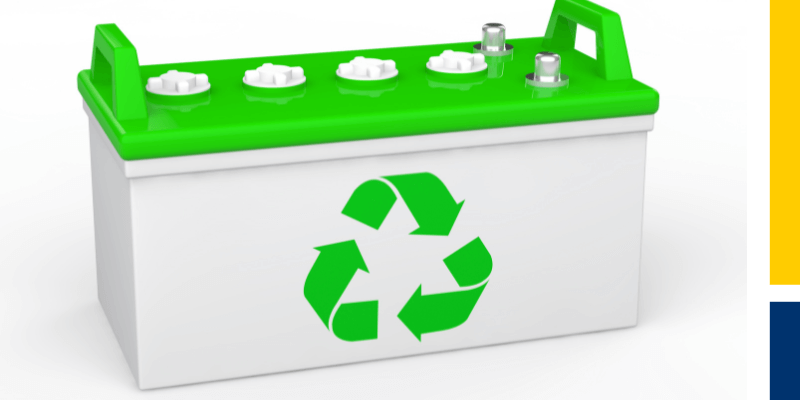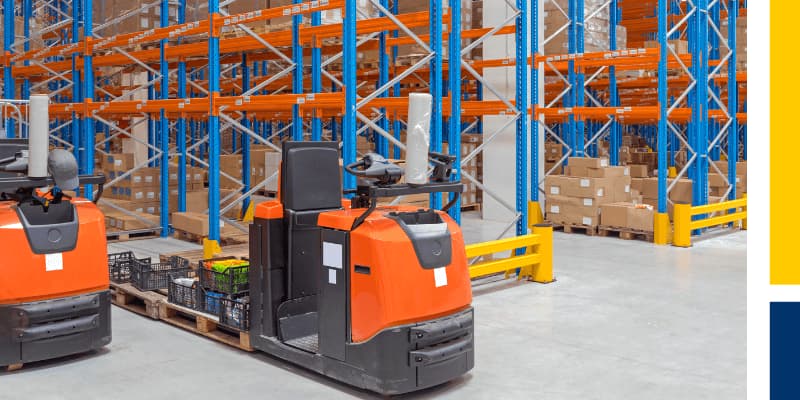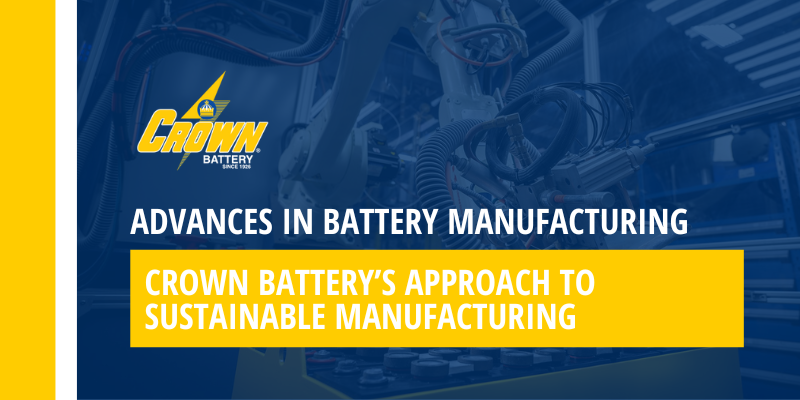And flooded lead-acid (FLA) and absorbent gel mat (AGM) batteries make sense for many applications – for your finances, operations, and safety.
But what are their pros and cons – and are they a sound investment for you?
In this blog post, you’ll learn five economic benefits of FLA and AGM batteries, including:
- Why are lead battery costs less than ½ the price of other battery chemistries?
- How FLA and AGM batteries reduce setup and installation costs
- Near Zero-Waste manufacturing techniques that lower your environmental impact and purchase price
- What you need to know about battery safety and fire mitigation
- Why FLA and AGM batteries are better for the environment – and your wallet
#1: Lower lifetime and upfront costs in most applications
Despite FLA and AGM batteries’ robotic assembly and proven track record, they’re generally 50% to 75% less expensive than comparable LI batteries.
Lead-based batteries typically offer more kWh of lifetime energy per dollar because they:
- Use ~80% recycled materials
- Don’t require expensive and difficult-to-extract metals (cobalt) or lithium brine
- Are already safe without needing expensive onboard BMS
Computerized modeling and robotic assembly revolutionized FLA and AGM batteries, improving lifespan, consistency, and performance.
Yet their underlying chemistry has over a century of safety, durability, and reliability in billions of installations. (For example, lead-based batteries start most of the world’s 1.47 billion cars – and partially or fully power most forklifts, golf carts, boats, and off-grid homes.)
#2: Easier, simpler, and cheaper installation and setup
Recyclable FLA and AGM batteries often feature straightforward, plug-and-play installation and require fewer additional components.
For instance, unlike Li-based batteries, FLA and AGM batteries don’t require Battery Management Systems (BMS) for safety.
You can often use existing fire safety equipment because lead-based batteries don’t suffer from the potential for multi-day thermal runaway or extreme temperatures in case of fire.
By contrast, many LI battery installations require new fire suppression systems, additional safety training, and coordination with local fire departments to ensure they’re adequately trained and equipped for Lithium-ion battery fire suppression. Some insurance companies even require more expensive policies if LI batteries are stored or used onsite.#3: Near-zero waste
Less waste = more resilient supply chains, greater manufacturing efficiency, lower pricing for you, and less pollution.
FLA and AGM batteries are 99% recycled – more than an aluminum can (source: US EPA’s “Advancing Sustainable Materials Management: 2018 Fact Sheet”)
Lead-based batteries require less mining because they incorporate approximately 80% recycled materials.
And in 2021 alone, Crown’s waste-reducing production equipment, processes, and engineering saved:
- 411,940 pounds (186,852 kg) of on-site materials recycled
- 1,441,790 gallons (5,457,768 liters) of wastewater reused through our 19-step filtration process
- 3,501 trees’ worth of fiber
- 865,074 Kilowatt hours of electricity -- enough to power 943 U.S. homes for a month (based on 11,000 kWh yearly usage per household; source: U.S. Energy Information Administration’s 2015 Residential Energy Consumption Survey)
- 700 cubic yards (535.18 cubic meters) of landfill averted - enough to cover a U.S. football field in 3 inches (7.62 cm) of recycled material
- 84,448 gallons (383,908 liters) of fuel saved
We pass some of those savings on to you – and reinvest the rest in further waste reduction and energy efficiency programs – a virtuous cycle.
Get your copy of the Zero Battery Waste Guide to find out which batteries reduce waste – and lower your energy storage costs.
#4: Disposal costs
All batteries die – but only some offer free recycling Let’s compare:
OPTION 1: FLA and AGM battery recycling is almost always free or nets you a profit… because the process is streamlined, mandatory, and profitable for recyclers.
OPTION 2: Lithium-based batteries face numerous hurdles to universal and profitable recycling… so you may foot the bill.
Eventually, emerging battery chemistries like lithium-ion (LI) and Lithium-ion phosphate (LiFePO4) will require recycling – just like lead-acid batteries.
But today, they don’t.
And LI battery recycling faces critical roadblocks:
- Fire hazardous complicate collection, transportation, and storage
- Lacking national collection infrastructure
- Difficulty sorting and disassembling batteries
- Inefficiency of existing recycling methods
- Low material value of most internal components (heavy metals like cobalt are being phased out, slashing the profitability of recycling)
With so many logistical, technical, and legislative hurdles…
… 95% of lithium-ion batteries today end up in a landfill. (Source: Chemical & Engineering News’s “It's time to get serious about recycling lithium-ion batteries”)
When spent LI batteries aren’t collected or recyclable, valuable materials like lithium need to be mined new. These resources are difficult to extract – at a heavy price for local communities and the environment. And as demand increases, supplies will come from increasingly remote and difficult-to-extract-from areas, increasing environmental and monetary costs.
We’ve already seen several LI battery users forced to pay disposal fees for spent batteries.
And unless universal battery collection and recycling become possible and profitable, you could face unexpected costs at the end of LI batteries’ life.
#5: Safety and Fire Mitigation
No matter which batteries you choose, battery safety is critical to protect yourself, your loved ones, and your employees.
Recyclable lead-based batteries have 100+ years of safe operation because:
- They aren’t vulnerable to large-scale thermal runaway, unlike LI models. (Li-based batteries are at greater risk of fires and explosions primarily due to higher energy density.)
- You’re protected by decades of published safety standards and best practices.
- Because FLA and AGM batteries aren’t prone to catastrophic thermal runaway, you won’t be subject to possible property/fire insurance price hikes aimed at LI-based batteries.
- Firefighters are already familiar with and equipped to extinguish FLA and AGM fires.
- There is virtually zero risk of lead battery electrolyte ignition in extreme cold.
- Lead battery cases enclose or seal in chemicals, protecting users.
- FLA and AGM batteries are so safe, they’re even permitted in airplane cargo holds. (Note that lead-based batteries require proper ventilation when in use.)
BONUS: Proven longevity in the field – not just in the laboratory
If something sounds too good to be true, it probably is.
Let’s look at how to tell the difference between battery longevity claims and reality:
Some battery chemistries make unsubstantiated lifespan claims – think, “10 years no matter what” – based solely on computerized models or accelerated laboratory tests.
While predictive testing is important for testing and validation, it doesn’t necessarily reflect the real world.
Although there’s little data to substantiate most 10-year battery lifespan claims, scientists and engineers have ample data about battery aging patterns:
All batteries lose capacity when they age. However, lithium-ion models are susceptible to significant increases in resistance, which can adversely affect performance, especially in short-duration applications. For instance, a mere 20% decrease in capacity can elevate DC resistance to levels surpassing 60%. (In comparison, AGM batteries with a similar 20% capacity reduction often see internal resistance rise by only around 30%.)
Take marketing claims and warranties with a grain of salt UNLESS battery manufacturers:
- Back up claims with real-world results
- Tell you the truth about which variables affect battery lifespan
- Stand behind strong, written warranties
- Have been in continuous operation for longer than their warranty period – or, if they’re startups, provide third-party insurance to protect your claim
Crown batteries have been field-tested and proven reliable for nearly 100 years, from Fortune 500 warehouses and communications towers to off-grid homes and cities, mining and military applications, and electric vehicles.
Crown batteries are engineered and assembled in the USA at our ISO 9001:2015-certified headquarters in Fremont, OH.
We tell you the truth: Battery lifespan varies based on several factors, including: engineering and assembly, quality of installation and ventilation, operating and charging temperatures, sizing and depth of discharge, and maintenance.
In many installations, AGM and FLA batteries typically last 3 to 7 years. In optimal conditions, they can last longer than a decade.
We’ll be here long after *any* battery on the market – and we’ve been in continuous operation since 1926.
And unlike startup battery manufacturers dependent on the next round of venture capital funding or quarterly reports…
Multiple generations of customers trust Crown Battery’s strong, written warranties and helpful US-based support.
Ultimately, only you can choose which batteries make sense for you.
And if you want to help protect your battery investment, click here to read “How to Understand Battery Warranty Terms and Conditions.”












